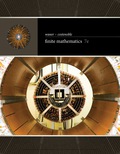
In Exercises 1–4, complete the given tables.
| Exponential Form |
|
|
|
|
|
|
| Logarithmic Form |
To fill: The following table,
| Exponent Form | ||||||
| Logarithmic Form |
Answer to Problem 1E
Solution:
The complete table is,
| Exponent Form | ||||||
| Logarithmic Form |
Explanation of Solution
Given information:
The given table is,
| Exponent Form | ||||||
| Logarithmic Form |
Consider the exponent,
The exponent form
Then the exponent form
Consider the exponent,
Since the exponent form
Then the exponent form
Consider the exponent,
Since the exponent form
Then the exponent form
Consider the exponent,
Since the exponent form
Then the exponent form
Consider the exponent,
Since the exponent form
Then the exponent form
Consider the exponent,
Since the exponent form
Then the exponent form
Hence, the complete table is
| Exponent Form | ||||||
| Logarithmic Form |
Want to see more full solutions like this?
Chapter 0 Solutions
EBK FINITE MATHEMATICS
- 3. A different 7-Eleven has a bank of slurpee fountain heads. Their available flavors are as follows: Mountain Dew, Mountain Dew Code Red, Grape, Pepsi and Mountain Dew Livewire. You fill five different cups full with each type of flavor. How many different ways can you arrange the cups in a line if exactly two Mountain Dew flavors are next to each other? 3.2.1arrow_forwardBusinessarrow_forwardWhat is the area of this figure? 5 mm 4 mm 3 mm square millimeters 11 mm Submit 8 mm Work it out 9 mmarrow_forward
- No chatgpt pls will upvotearrow_forwardFind all solutions of the polynomial congruence x²+4x+1 = 0 (mod 143). (The solutions of the congruence x² + 4x+1=0 (mod 11) are x = 3,4 (mod 11) and the solutions of the congruence x² +4x+1 = 0 (mod 13) are x = 2,7 (mod 13).)arrow_forwardhttps://www.hawkeslearning.com/Statistics/dbs2/datasets.htmlarrow_forward
- Determine whether each function is an injection and determine whether each is a surjection.The notation Z_(n) refers to the set {0,1,2,...,n-1}. For example, Z_(4)={0,1,2,3}. f: Z_(6) -> Z_(6) defined by f(x)=x^(2)+4(mod6). g: Z_(5) -> Z_(5) defined by g(x)=x^(2)-11(mod5). h: Z*Z -> Z defined by h(x,y)=x+2y. j: R-{3} -> R defined by j(x)=(4x)/(x-3).arrow_forwardDetermine whether each function is an injection and determine whether each is a surjection.arrow_forwardLet A = {a, b, c, d}, B = {a,b,c}, and C = {s, t, u,v}. Draw an arrow diagram of a function for each of the following descriptions. If no such function exists, briefly explain why. (a) A function f : AC whose range is the set C. (b) A function g: BC whose range is the set C. (c) A function g: BC that is injective. (d) A function j : A → C that is not bijective.arrow_forward
 Glencoe Algebra 1, Student Edition, 9780079039897...AlgebraISBN:9780079039897Author:CarterPublisher:McGraw Hill
Glencoe Algebra 1, Student Edition, 9780079039897...AlgebraISBN:9780079039897Author:CarterPublisher:McGraw Hill
